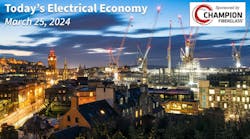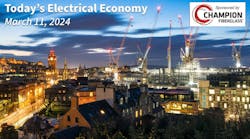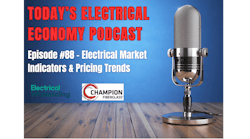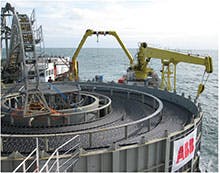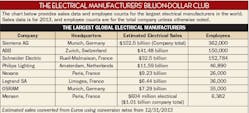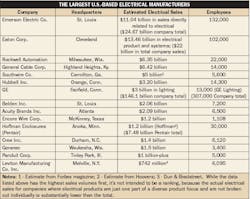As editors of Electrical Wholesaling, we get to report on all sorts of different types of news. Some days the first story that comes across our desks is a blockbuster merger or acquisition. Other times, we uncover a new technological development with the potential for dramatic impact on the electrical market. Part of the fun that comes with our jobs is analyzing the potential impact of these stories on our readers and deciding how much weight to give them.
Over the past two or three years, we have noticed some manufacturers are in the news much more than others. While these companies often hit the headlines because of big acquisition or a major executive move in the C-suite, more often than not the story is about how a company is dealing with one of five key trends that Electrical Wholesaling’s editors believe are utterly changing the electrical wholesaling industry as we know it:
- The lighting transformation to LEDs
- The energy revolution
- The evolving power grid
- Our more-connected world
- Market opportunities with the new logistics of moving products through more-modern ports, intermodal facilities and rail lines
We have written quite a bit about these megatrends over the past few years in Electrical Wholesaling, and you can find links to these articles in the digital version of this article on www.ewweb.com. On page 16 you will see several “points to ponder” about how your company can deal with key challenges/opportunities within each of these megatrends.
ABB
Zurich, Switzerland
Senior executive: Ulrich Spiesshofer, CEO
2013 sales: $41.48 billion
The Zurich, Switzerland-based ABB is being applauded for the integration of its 2012 acquisition Thomas & Betts Corp., Memphis, Tenn., for $3.9 billion. Some European mega-manufacturers appear to prefer having senior managers for the North American market cycle through every few years and don’t seem to want to adapt to the U.S. electrical market’s distribution strategies and business practices. Instead, they tend to run their U.S. operations in much the same manner as business units in Europe. But ABB bought Thomas & Betts for its far-flung distribution network and seems to be quite content with allowing T&B execs to handle many key decisions stateside. The company also purchased Baldor in 2011 and that acquisition has also been received positively.
The 120-year-old ABB employs 150,000 people and operates in approximately 100 countries. Along with its businesses in the electrical distribution and motor markets, the company also has a major focus on utility-scale power systems, automation, wind farms, control systems for cargo loading systems in shipyards, and power systems for ships and other maritime applications.
OSRAM
Munich, Germany
Senior executive: Wolfgang Dehen, CEO
2013 sales: $7.29 billion
Few companies have seen the promise of LEDs but felt the pain of the transition away from traditional lighting sources as clearly as OSRAM. In late July, the company announced it would be making 7,800 additional job cuts through 2017 to save approximately $349 million as it evolves from a product mix where LEDs currently account for 29% of revenues to where they have a more commanding share of its business. The job cuts could eventually touch about 22% of the company’s 35,000 staffers around the world.
All the turmoil accompanying this transition comes soon after the company’s tumultuous spin-off from Siemens, which was finalized in July 2013. Siemens and a Siemens pension plan control a total of 19.5% of the now-public OSRAM (OSRAM Licht AG) which trades on the Frankfurt and Munich Stock Exchanges under the symbol “OSR.”
Despite this painful transition, the company still made a bold statement with new solid-state lighting products at the most recent LightFair International. The company won two prestigious LFI Product Awards, one for the OSRAM
DEBUT interactive lighting system for retailers, which won the Judges’ Citation Award, and the Best of Category award for its
OPTOTRONIC Outdoor Programmable LED Power Supplies. In more recent news, the company announced that its U.S. Sylvania business would be moving its headquarters from the Danvers, Mass., facility it occupied for many years to nearby Wilmington, Mass.
PHILIPS
Eindhoven, Netherlands
Senior executive: Eric Rondolat, CEO Philips Lighting
2013 sales: $11.59 billion
With its end-to-end lighting solution, and global lighting sales of $11.59 billion, Philips is now by far the largest lighting manufacturer in the world. The company became a major player in the LED lighting market with its acquisitions of Lumileds in 2005 and Color Kinetics 2007. Philips has a long and rich acquisition history. In 2007, it bolstered its lighting fixture business with the purchase of Genlyte and its stable of well-known brands such as Lightolier, Day-Brite, Capri, Thomas Lighting and Hadco. Much earlier in its history it got into the ballast business through a 1959 acquisition of Advance Transformer Co. and added to its lamp division with the purchase of Westinghouse Lamp division in 1983.
Today, the company is transitioning its lighting business over to LEDs and reports that LEDs now account for 29% of its total 2013 sales. In its 2013 annual report, it said that by 2015 LEDs will have a 45% share of the total market.
Despite all the excitement about LEDs, Philips said in its annual report that the lighting market overall is expected to grow by a fairly middling 4-6% on a compound annual basis between 2013 and 2016. The company’s lighting business grew 3% in 2013, excluding a 3% negative currency effect. Down the road, Philips expects continued competition from the two largest established players, GE and OSRAM, as well as new competition from Asia and new players from the semiconductor and building management sectors.
In 2013, the company proudly announced that it had created the first LED lamp prototype delivering 200 lumens per watt of high-quality light, halving energy use compared to other LED lamp technologies at the time.
SCHNEIDER ELECTRIC
Rueil-Malmaison, France
Senior executive: Jean-Pascal Tricoire, chairman & CEO
2013 sales: $32.5 billion
As one of the largest “pure-play” electrical companies in the world, Schneider Electric’s businesses seem to touch each of the mega-trends mentioned earlier in some manner. Its growing Juno Lighting business is right in the middle of the LED transformation. The company is heavily involved in electric vehicles, renewable technologies like solar and wind, and has a major effort in UPS equipment and power systems for data centers. And an enormous portion of its product portfolio is dealing with the “internet of things,” including its factory floor automation equipment, LED fixtures, residential control systems and distribution and switchgear for commercial and industrial applications. It’s also heavily involved in smart-grid technology through its 2011 acquisition of Telvent and earlier this year solidified its industrial automation offering with the purchase of Invensys, a provider of advanced software solutions and power solutions for the factory automation market.
The company is very serious about adapting its global operations to the mega-trend of a more urbanized world and has restructured is business to focus on the urban and emerging markets. Its stable of brands include well-known electrical names like Square D, Telemecanique, Juno Lighting and APC.
SIEMENS
Munich, Germany
Senior executive: Joe Kaeser, CEO
2013 sales: $102.5 billion in total, probably over $80 billion in electrical products, with a heavy emphasis on high-power energy solutions.
Siemens has major businesses in offshore wind turbines, utility-scale power production, railroad engines and building control systems. The company is still a player in products for the low- and medium-voltage electrical equipment and industrial control products for the factory floor, but since it spun off OSRAM, the company no longer has a major presence in the lighting market. It’s tough to get an exact number for revenues from electrical products because the company appears to have electrical products and systems spread throughout three of its four major business units (Industry, Infrastructure & Cities, Energy and Health Care). Despite some financial and management missteps over the past decade, Siemens is still a massive presence to be reckoned with on the world stage, with over $100 billion in total annual sales and no less than $88.9 billion in global sales of products for the power generation, building, energy and infrastructure markets.
